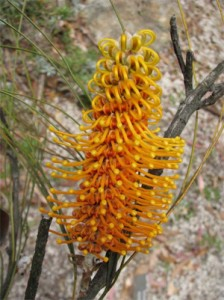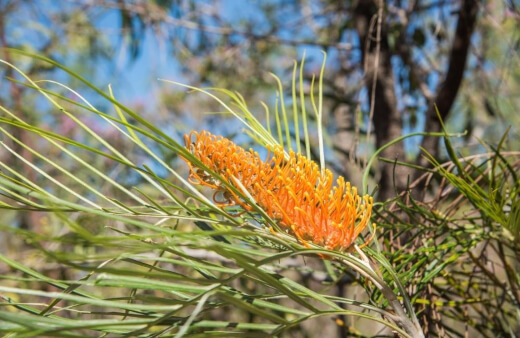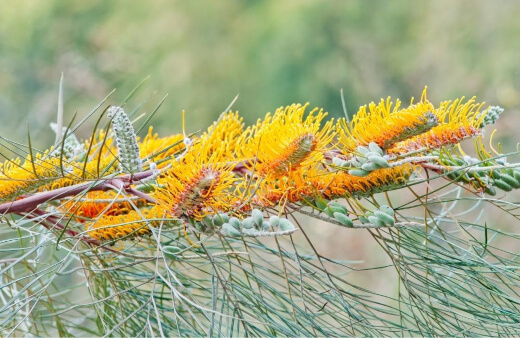Endemic to Western Australia, the Grevillea excelsior or flame grevillea is a large shrub that forms a part of the Proteaceae family. This shrub thrives in full sun and can grow to be around 4 metres high and 3 metres wide.
This species is large-growing and would take up a good chunk of your garden. Many growers, therefore, use it as a feature plant in the centre of their gardens with other smaller shrubs planted around the outside.
More...
Introducing Grevillea excelsior
Genus: Grevillea
Species: G. excelsior
Family: Proteaceae
Common Name: Flame Grevillea, Orange grevillea
Flower Colour: Orange
Foliage Colour: Green
Growth Habit: Shrub 3m+
Flowering: Winter to Spring

Characterised by bright orange flowers that bloom in winter through spring, atop luscious and rugged green foliage, this gorgeous native shrub is accessible to beginner and expert growers alike.
Due to its large, toothbrush-like orange flowers, the Grevillea excelsior is also an excellent bird and honeyeater attracting plant.
Provided with the correct growing environments, these evergreen shrubs are known to be fast-growing. Once fully matured, the flame grevillea will be frost and drought resistant.
How to Grow Grevillea excelsior

Due to this species of Grevillea being one of the larger specimens in the family, they are mostly planted outdoors in gardens. Although this shrub is tough and native to the Australian climate, knowing what conditions allow it to thrive will ensure you can successfully grow and care for your Grevillea excelsior the first time around.
Soil Preference
Flame grevillea prefers sand or gravel-based soil that is well-draining. This means that the soil should be loose and shouldn’t be overly compact after watering to allow for sufficient drainage to prevent the roots from rotting.
The soil should also be rich in organic matter so using some organic compost and mulch can be a great option to allow for healthy, breathing soil.
Sunlight Needs
These shrubs are lovers of the sun. They thrive in full sun locations but can also manage in semi-shaded areas. However, the Grevillea excelsior will grow fewer flowers in more shaded locations where growth can be stunted slightly.
Therefore, the more sun it receives, the bigger and healthier the plant will grow to be. Ideally, they should receive at least a half-day of full sun.
Humidity & Temperature
Grevillea excelsior can grow well in most climates that experience good sunlight. Being Australian natives, they will thrive in most areas throughout Australia.
As long as they receive a lot of light, temperature and humidity levels are not a major concern. Once matured, they also become even tougher and tolerate more severe weather conditions.
Propagating Grevillea excelsior

The most common method used to propagate this shrub is by using cuttings. Propagation by seed is also possible but the success rate is not as high. We will look at both methods in detail.


Get Your Free Guide:
Master Growing Australian Natives eBook
A Must Have Complete Guide for Every Australian Garden
Get Your Free Guide:
Master Growing Australian Natives eBook
A Must Have Complete Guide for Every Australian Garden
Propagation Orange Grevillea by Seeds
Seeds can generally be sown throughout most of the year in Australia however it is recommended to sow during the more temperate months in spring or autumn.
As long as you avoid sowing during the coldest or hottest periods of the year, you should be fine. Ideal temperatures for seed germination are between 18 to 22°C.
Larger seeds of the Grevillea excelsior can be carefully sliced with a sharp knife to expose the embryo a little before sowing. This can help the seed absorb more moisture and accelerate germination. This is however optional.
Here is how you can propagate flame grevillea using seeds:
- Soak your seeds in warm water overnight.
- Using a tray or separate pots, sow your seeds about 3 millimetres deep into your potting mix. Avoid burying the seeds too deep.
- Place in a warm, shaded location to avoid the soil from drying out.
- Your container should be well-draining but allow the soil to remain damp between waterings.
- Keep the soil moist but not wet. Try to avoid letting the soil mix completely dry out.
- Germination should occur within 21 to 60 days depending on the conditions.
Many seeds from native plants can be dormant and require specific conditions to germinate. Don’t be too hasty and discard your seeds if they are not germinating.
They could just be waiting for conditions to be optimal, similar to those of their natural habitats before they germinate and sprout successfully.
Propagating Flame Grevillea Using Cuttings
Between October and March after the flowering season, new growth should appear. To propagate Grevillea excelsior using cuttings, follow these steps:
- Using sharp, clean scissors or shears (see our pruning shears buying guide if you are in the market for one), take a cutting of about 10 centimetres from the new growth. Make sure the cutting is healthy and disease-free.
- Trim the foliage off the lower section of the cutting without damaging the stem. You can also remove any shoots or young flowers.
- Dip the stem of the cutting into some rooting hormone.
- Plant the cutting into your propagation soil mix in a well-draining container. Alternatively, you can use the same soil that the donor plant was in.
- Keep the soil moist by misting and checking when water is needed.
- Keep the container away from harsh, direct sunlight in a warm, bright location with plenty of indirect light.
New roots should start to appear in about 4 to 8 weeks. Thereafter, wait for about 3 to 4 months for the roots to develop before planting the shrub in the garden.
You can choose to try to grow a few cuttings at once so that your chances of success are greater. Extra plants can always be gifted.
Planting Flame Grevillea

Once your cutting has begun to produce new growth and has developed itself, it’s time to plant it into your garden. Be sure to pick out a large, well-lit location with well-draining soil. Planting in spring or autumn is recommended.
Here’s how you can plant your Grevillea excelsior:
- Dig a hole that is twice as big as the root ball of your shrub. Loosen the soil at the bottom of the hole.
- Gently remove your from its current container and place it into the hole in your garden.
- Be sure that the top of the root system is about level with the surrounding soil. Fill in the remaining soil being sure to not over compact the soil.
- Water the shrub well for the first couple of days after planting.
As mentioned, this shrub grows to be large so be sure that there aren’t too many plants near your newly planted grevillea. A distance of around 1.5 to 2 metres on either side should suffice.
Grevillea excelsior Companion Plants
There are some excellent companion plants for your flame grevillea. These plants are known to grow well under and around the shrub. Consider pairing your Grevillea excelsior with:
- Kangaroo Paw - Kangaroo Paw Plant Popular Types and Growing Guide
- Lilly Pilly - Lilly Pilly Plant Grow and Care Guide
- Banksia Birthday Candles - Banksia spinulosa Growing Guide
- Yellow Buttons
Orange Grevillea Care Tips

When it comes to caring for your Grevillea excelsior, the shrub won’t require much upkeep at all. They are very hardy and self-sustainable plants once established. However, in the initial growth stages, as the plant develops, there are a few things you can do to keep your plant healthy and happy.
Here are our top care tips:
Nutrients
As the flame grevillea is a native plant, it will require little to no fertiliser. However, in its first year after planting, it can be beneficial to add a little slow-release low phosphorus fertiliser every couple of months.
Consider using a 13-2-13, a 14-0-14 or a native blend fertiliser. Do not fertilise at all once the shrub is fully grown.
Watering Flame Grevillea
Once fully established, this shrub is pretty water-wise and won’t require much upkeep in terms of a watering schedule as they can thrive mostly off of rainwater alone. Watering once per week during hot spells with your retractable hose reel is recommended (especially during very hot spells).
Pruning
Your Grevillea excelsior will respond well to light pruning after the flowering season is over. Tip pruning during the flowering season can help encourage more blooms as well.
If you find the shrub is looking a tad leggy and you want more density in the growth, you can cut back around one-third of the foliage to stimulate thicker growth.
Grevillea excelsior Pests, Problems & Diseases

Overall, the Grevillea excelsior is extremely hardy. Being a native, they are resistant to most pests and diseases. The most common issues these shrubs face in gardens is a lack of sunlight and waterlogged soil.
Both of which can be avoided if you plant your shrub in a location with full sun for most of the day and if you are careful not to overwater your flame grevillea.
Other rare diseases may include:
Sooty Mould
Also known as black mould, this fungal issue is caused by mould spores feeding off of remains left by sap-sucking insects. You will notice dark brown mould spots beginning to develop on the stems and foliage of your shrub.
You can wash off the mould with a weak soap solution or by using neem oil.
Phosphorus Toxicity
Grevillea excelsior is very sensitive to phosphorus. They have developed their own ability to draw very small amounts of phosphorus from native soil using their roots.
If you notice that your new growth or foliage is starting to scorch and yellow, this should indicate that your soil's phosphorus content is too high.
Stop using any fertiliser near the plant and soak the soil to try to leach any remaining phosphorus out of the ground. The shrub should recover in due time.
Frequently Asked Questions About Grevillea excelsior
Why do my grevilleas keep dying?
Most of the time this is caused by poor drainage in the soil which leads to root rot problems. The shrub can begin to turn brown with droopy branches.
Don’t water further and consider replanting the shrub in another location with better draining soil.
Do grevilleas like wet feet?
Grevilleas love the sun but do not like wet feet. They prefer a slopping or raised garden bed. They can tolerate dry conditions well so once established, watering once per week is sufficient.
How fast does grevilleas grow?
Grevillea is very fast-growing and can live for a long time. Being a native shrub, it has adapted well to the Australian climate and has learned to thrive in these conditions.
Interested in growing more Grevillea varieties? See our main Grevillea guide for more options.

Embrace the Majestic Presence of Grevillea excelsior in Your Garden
A hardy Australian native that not only attracts the eyes with its beautiful, bulbous and brilliantly orange flowers but also attracts wild fauna, the flame grevillea is a fantastic option for gardeners and growers who want to add some wild colour and texture to their garden beds.
Requiring little maintenance and little expertise, the Grevillea excelsior is a must-have native shrub for any garden.
Published on March 5, 2022 by Nathan Schwartz
Last Updated on January 26, 2025




